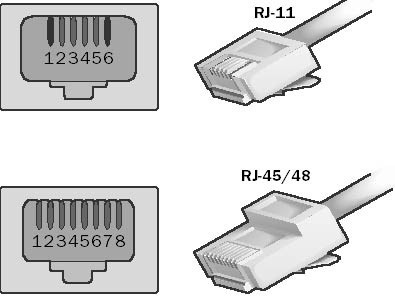Definition of RJ connectors in The Network Encyclopedia.
What are RJ connectors?
RJ Connectors are a family of push-and-click connectors for twisted-pair wiring in telephone and network wiring. RJ stands for Registered Jack. RJ types define both a jack or receptacle (female) and a plug (male) type of connector.

The most common types of RJ connectors are as follows:
- RJ-11 connector: A 4-wire or 6-wire telephone-type connector that connects telephones to wall plates. RJ-11 supports up to six wires, but usually only four are used with the two-pair twisted-pair cabling commonly found in telephone cabling. Best seller of RJ-11 connectors on Amazon (according to over 53 customer reviews)
- RJ-45 connector: An 8-wire telephone-type connector used with twisted-pair cabling for connecting computers, wall plates, patch panels, and other networking components. RJ-45 is the standard type of connector for both unshielded twisted-pair (UTP) and shielded twisted-pair (STP) cabling in star-topology Ethernet networks such as 10BaseT and 100BaseT4. RJ-45 is defined in International Organization for Standardization (ISO) standard 8877. Best seller of RJ-45 connectors on Amazon (according to over 220 customer reviews)
- RJ-48 connector: An 8-wire telephone-type connector used with twisted-pair cabling for connecting T1 and 56-KB digital data service (DDS) lines. RJ-48 uses the same jack as RJ-45 but uses a different pinning, with one pair of wires to transmit signals, one pair to receive signals, one pair for drain, and one unused pair (reserved for future use). RJ-48 connectors come in three varieties: RJ-48C and RJ-48X for connecting T1 lines, and RJ-48S for connecting 56-KB DDS lines. RJ-48 connectors on Amazon
NOTE
The diagram above shows RJ-11 and RJ-45/48 connectors, which are used to terminate both ends of UTP cabling. Pins are labeled 1 through 4 or 1 through 6 for 4-wire and 6-wire RJ-11, and 1 through 8 for 8-wire (four-pair) RJ-45/48. Cables can be straight-pinned or cross-pinned, depending on their use. For example, a straight-pinned RJ-45-terminated UTP cable is used to connect a computer to a 10BaseT hub, while a cross-pinned cable or crossover cable is used to connect two computers directly or to connect two hubs.
The following table shows the pinning for these various cables, with the colored wires coded as follows:
- Y = yellow
- G = green
- R = red
- W = white
- S = silver
- OR = orange
- BL = blue
- BK = black
- BN = brown
If these colors are combined in striped cables, the coloring is coded OR/W for orange/white or orange with white striping, and so on. RJ-11 and RJ-45 cables generally use solid-color wires, while RJ-48 cables are usually striped. Note that RJ-45 has two types of cross-pinning: 568A/B and USOC. If the pinning of a wire is listed as Y (1–4), it means that the yellow wire is connected to pin 1 at one end and to pin 4 at the other.
Professional crimp tool TC-CT68 crimps, strips, and cuts cable for 8 and 6 position modular plugs: Best deal on Amazon
Types of Cable Pinning
| Connector/Cable | Pinning |
| RJ-11 straight (4-wire) | Y (1-1), G (2-2), R (3-3), BL (4-4) |
| RJ-11 crossed (4-wire) | Y (1-4), G (2-3), R (3-2), BL (4-1) |
| RJ-11 straight (6-wire) | BL (1-1), Y (2-2), G (3-3), R (4-4), BK (5-5), W (6-6) |
| RJ-11 crossed (6-wire) | BL (1-6), Y (2-5), G (3-4), R (4-3), BK (5-2), W (6-1) |
| RJ-45 straight (8-wire) | BL (1-1), OR (2-2), BK (3-3), R (4-4), G (5-5), Y (6-6), BN (7-7), S (8-8) |
| RJ-45 USOC crossed (8-wire) | BL (1-8), OR (2-7), BK (3-6), R (4-5), G (5-4), Y (6-3), BN (7-2), S (8-1) |
| RJ-45 568A/B crossed (8-wire) | BL (1-3), OR (2-6), BK (3-1), R (4-5), G (5-4), Y (6-2), BN (7-8), S (8-7) |
| RJ-48C straight (8-wire) | OR/W (1-1), W/OR (2-2), (3-3) unused, BL/W (4-4), W/BL (5-5), (6-6) unused, BL drain (7-7), OR drain (8-8) |
| RJ-48C crossed (8-wire) | OR/W (1-4), W/OR (2-5), (3-3) unused, BL/W (4-1), W/BL (5-2), (6-6) unused, BL drain (7-7), OR drain (8-8) |